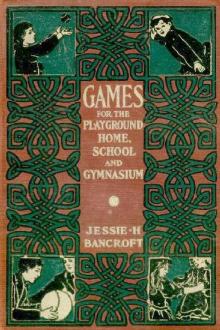Games for the Playground, Home, School and Gymnasium by Jessie Hubbell Bancroft (top novels of all time .txt) 📕

- Author: Jessie Hubbell Bancroft
- Performer: -
Book online «Games for the Playground, Home, School and Gymnasium by Jessie Hubbell Bancroft (top novels of all time .txt) 📕». Author Jessie Hubbell Bancroft
5 to 30 or more players.
Schoolroom; playground; gymnasium.
All of the players but one are disposed in the corners or at convenient goals that will answer the same purpose. The odd player goes from one to another, saying, "Pussy wants a corner!" The player to whom this is addressed replies, "Go to my next-door neighbor." Any two of the other players meanwhile watch their opportunity to beckon to one another for exchanging places. They try to make this exchange of signals and to dash across from place to place when the attention of Puss is attracted in some other direction, as Pussy must try to secure a corner by rushing to any place that is vacant when the players thus exchange.
The sport of the game consists very largely in tantalizing Puss by making many exchanges, or, on the other hand, in Puss suddenly dashing for some vacant place without giving previous evidence of knowing of it. Whenever Puss secures a corner, the odd player left out becomes Puss.
Puss, when not succeeding in getting a corner as soon as desirable, may call "All change!" when all of the players must exchange places, and in the general flurry Puss should secure a place.
Out of doors.—This game may be very delightfully adapted to outdoor play by each player taking a tree as a "corner," when the dodging and running may be much more varied and interesting than in the open space of a parlor or gymnasium.
PUSS IN THE CIRCLE10 to 30 or more players.
Playground; gymnasium.
A large circle is marked on the ground or floor. One player, who is Puss, stands in the center of this circle; the other players stand outside of the circle surrounding it. These players may be tagged by Puss whenever they have a foot inside of the circle. They will make opportunity for this by stepping in and out of the circle, teasing Puss in every possible way to tag them. Any one whom Puss touches becomes a prisoner and is another Puss, joining the first Puss in the circle to help tag the others. The last one tagged is the winner of the game.
This is one of the games particularly suited to make a timid child courageous, and a teacher or leader using the game with little children should urge such timid children to take an active part in the game.
RAILROAD TRAIN10 to 100 players.
Parlor; schoolroom; out of doors.
Each player is named for some object on a train, such as engine, baggage car, dining car, smokestack, boiler, cylinders, wheels, oil, coal, engineer, porter, conductor, etc. One person is chosen to be the train master. He says in narrative form: "We must hurry and make up a train to go to Boston. I will take Number One engine and some coal; have the bell rope in order; be sure that the cushions are brushed in the sleeping car," etc. As he names these objects, the player bearing each name runs to the starter and lines up behind him, each putting his hands on the shoulders of the one in front, the first one placing his on the shoulders of the starter. When all are on the train, the starter gives the signal for going, and the whole train moves out on its journey, which at the discretion of the starter will be up hill over obstacles, down hill from others, around loops and curves, etc.; and he may, under suitable circumstances, find a convenient place for a grand "smash-up" at the end.
For large numbers there should be several starters, starting several trains at once, and these may race for a given point at the end.
RED LION5 to 30 or more players.
Playground; gymnasium.
A place is marked out at one side or end of the ground called the den. In this stands one player who is called Red Lion. The other players choose one of their number as a chief, who does not run, but stands at one side and directs the movements of the others. The chief calls "Loose!" to the Red Lion. After hearing this signal, the lion is free to run out whenever he chooses. The players venture near to the den, taunting the lion with the lines:—
Whoever you catch will be one of your men."
When the Red Lion thinks the players are sufficiently near to give him a good opportunity to catch one, he makes a sudden sortie and catches any player that he can. The player is not his prisoner until the Lion has held him and repeated three times "Red Lion!" Both the Lion and his prisoner must hurry back to the den, as all of the other players may turn upon them at once to drive them back with blows. This is generally restricted to hitting with caps. Thereafter, when the Red Lion issues forth, he must take the prisoner with him, hand in hand, both of them endeavoring together to catch one of the other players by putting their arms over his head.
The Red Lion and his man may not issue, however, from their den until the chief calls "Cow catcher!" or some other signal, as explained below. As in the previous case, when a prisoner is caught, he and his captors hurry to the den to avoid the buffeting of the other players. Each time that the Red Lion goes forth, all of his prisoners must go with him. The method in which they go, however, and in which they capture their prey, will be determined by the signals of the chief. When he calls "Cow catcher!" they must all run out in a long string, hand in hand, and capture their prisoner by any two in the line slipping their clasped hands over his head. If the chief calls "Tight!" the Red Lion and his men go forth in the same way, holding hands, and try to capture a player by surrounding him and so take him to the den. Should the chief call "Doubles!" then the Red Lion and his men come forth two by two, and try to capture their prisoners. The order in which these varied commands are given is entirely at the discretion of the chief.
At any time when the Red Lion and his men are out on the hunt, any of the other players may try to break apart the clasped hands of the hunters. Whenever this is done, the lions must rush back to their den, being driven back and buffeted by the outside players. The game ends when all of the men have been captured by the Red Lion's party. The last man to be caught is the winner, and becomes Red Lion for the next game.
RING-A-LIEVIO10 to 30 or more players.
Out of doors.
This is a form of Hide and Seek in opposing parties. Players who are caught are prisoners and may be freed as described. The method of capture also differs from that in some other forms of Hide and Seek.
A small goal or den about five feet square is drawn at some central point.
Two leaders are chosen who alternate in choosing players, until all are disposed in two groups. Lots are drawn or counting out resorted to between the captains to determine which side shall start out first. The remaining group takes its place in the den while the opponents go to some distant point, from which they call "Ready!" and immediately scatter and hide.
The group in the den, as soon as they hear the call "Ready!" start out for the chase, leaving one of their number to guard the den. Whenever a player is caught (tagging is not enough; the player must be firmly secured), the catcher calls "Caught! Caught! Caught!" and leads his prisoner to the den. The object of the game is to make prisoners of all of the hiding team. A prisoner may be freed from the den by one of the players from his group running out from his hiding place and tagging him. This may only be done, however, by the rescuer getting both feet in the den. Should this be accomplished, the rescuer calls "Ring-a-lievio!" as he dashes through the den, and both run for safety. The den keeper tries to catch them as they run away, but may not chase them beyond certain boundaries, which must be determined beforehand. Only one prisoner may be freed at a time. Prisoners are most easily freed when there are several in the den at once and the den keeper's attention is distracted to one side of the den while the prisoners are freed from the other.
This game, like all hiding games, is especially adapted to open spaces, offering many hiding places, such as the edge of a wood, a garden, park, or playground having considerable shrubbery, or to a village street.
RINGMASTER10 to 60 players.
Playground; gymnasium; parlor.
This may be made a very amusing game for young children. One is chosen for ringmaster and stands in the center. If he can flourish a whip like a true ringmaster in the circus, the interest of the game will be enhanced. The other players form a circle around him without clasping hands.
The ringmaster turns and moves around in a circle, snapping his whip at each flourish, and calling the name of some animal. The players in the circle immediately imitate the animal, both as to its movements and cries. For instance, for a bear they claw or run on "all fours," or climb and at the same time growl; for a frog they may hop or swim and croak. The list may include the hopping kangaroo, the snarling and springing tiger, the humped and swaying camel, the balking and braying donkey, the flopping and barking seal, the scratching and cackling hen, the ponderous and mooing cow, the neighing and galloping horse, etc.
The ringmaster at his discretion may announce, "We will all join the circus parade!" whereupon all of the animals should gallop around the circle in characteristic movements, each choosing an animal that he likes to represent.
ROBBERS AND SOLDIERS10 to 100 players.
Out of doors.
This game is best played in the country, where there are woods in which the robbers may hide.
The players are divided between robbers and soldiers, there being about ten robbers to fifty soldiers (the proportion of one to five). The larger and stronger players are usually selected for the robbers. The soldiers have one General who directs their movements, and the robbers a Captain. The robbers are given five or ten minutes' start





Comments (0)